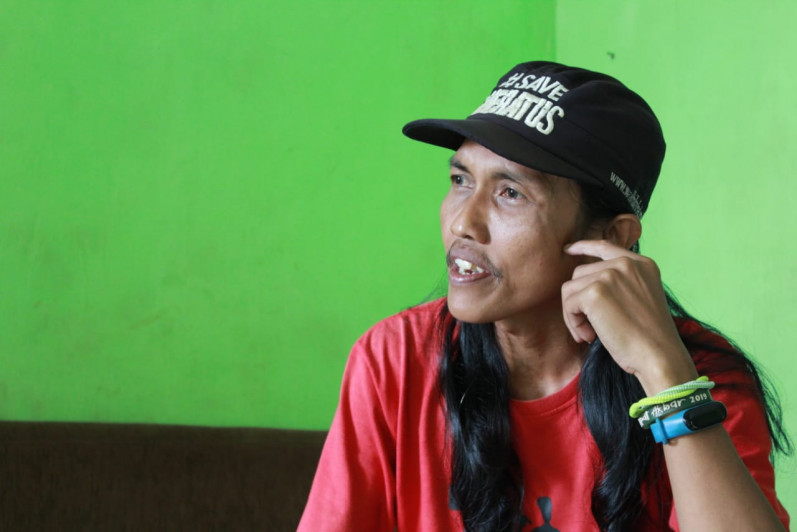Saving the Muaro Jambi Peat Orchid
By Yitno SupraptoUsing Local Wisdom as a Key Factor for Peat Swamp Ecosystem Management in South Kalimantan

Rain continues to fall in most of South Kalimantan at the end of the year – it is estimated to continue until February or March the following year – and brings "luck". The flooding in various areas in South Kalimantan is occurring at a multitude of scales. However, the rain prevented the long dry season from happening. The ongoing wet drought has at least managed to prevent haze, like in 2015 - 2020.
This has provided an important note. The lack of massive forest fires, as well as land fires, could be a result of the high precipitation. Therefore, this achievement was not only a result of the Peatland Restoration Agency or BRG performing their job well, as an institution that was established by President Joko Widodo and given the duty to handle peat swamp ecosystems issues in a number of provinces – including in South Kalimantan.
In addition to the various programs of the BRG, which was established on 6 January 2016 through Presidential Regulation Number 1 of 2016 concerning the Peatland Restoration Agency, the Banjar tribe's local wisdom in South Kalimantan also plays an important role. As documented by several researchers, the Banjar tribe is an almost incomparable conqueror of peat swamp land. The Banjar people won’t stop until they’ve conquered the peat swamp land, which is very hard to cultivate due to its high acidity and various other issues.
In the hands of the Banjar people, the peat swamp ecosystem area no longer becomes a tale of mourning or an abandoned area. One area that shows how successful the Banjar people are in conquering and utilizing peat swamps is Nagara, Hulu Sungai Selatan. This area has been known to be a producer of iconic agricultural products. Watermelon, Gumbili or Nagara Cassava, Nagara Peanuts, and other vegetables are the main products cultivated from the community’s agricultural activities in the peat swamp land. In addition, the Paminggir community of Hulu Sungai Utara, Banjar, Barito Kuala still maintain a livelihood on the side of the Swamp Buffalo and through fisheries of such fish species such as Haruan (Snakehead murrel), Sepat, Papuyu (Betok), Tauman, Saluang, Galah Shrimp, Pangas Catfish, Asian Redtail Catfish, Kalabam, and Lampam. The community is also famous for its purun weaving, which is used to produce mats, bags, hats, and other merchandise.
In addition to agricultural activities, a number of villages in the area also produce livestock (swamp buffalo) which are sold for their meat to various areas in and outside of South Kalimantan. The typical peat swamp grass is an abundant food source for the residents' buffalos. The buffalos are usually herded by their owners and are allowed to move freely in the swamp. The buffalo movements in the swamp also contribute to the environmental sustainability of Nagara (HSS) and Hulu Sungai Utara.
The peat swamp ecosystem also has abundant fishery potential and becomes a source of livelihood. The freshwater fish species found in peat swamp areas are Saluang, Sepat, Siam Sepat, Haruan (Snakehead murrel), Papayu, Tauman, Galah Shrimp, Asian Redtail Catfish, Pangas Catfish, Kalabam, and Lampam. Since fish is abundant during high tide in this area, these fishes are usually preserved by processing them into dried fish or salting them (Iwak Wadi).
Pools or fish ponds in Nagara are usually naturally established, with catfish and tilapia as the primary cultivated species. During the fish harvest period, the community is usually able to harvest large amounts of fish. They are even able to make tens to hundreds of millions of rupiah from harvesting the fish, especially during the dry season. This area goes through a natural process. Its residents and fellow ecosystem beneficiary are interrelated and they work hand in hand to maintain its environmental sustainability. In this area, the peat swamp ecosystem is truly a source of life and source of livelihood.
The conversion of the peat swamp ecosystem into a source of life and livelihood does not come naturally or in a short period of time. Through a long historical process, the people in various areas in South Kalimantan manage peat swamps using extraordinary local wisdom. This wisdom has existed long before peatlands were cultivated and converted into agricultural areas. This is reflected in the agricultural tools that the communities have developed. Their ability to develop their blacksmithing skills, which is a legacy from the Majapahit era, and creating agricultural tools to suit the peat soil characteristics.
The community in this area use agricultural tools i.e. tajak, machetes of various sizes, shapes, and functions, and plant local agricultural varieties – including a rice species that could survive being inundated by water so they can harvest rice using jukung or small boats – which are suitable for them and could be tailored to suit the local soil and water characteristics.
Even water, which is available all year long, is also an extraordinary gift from God for humans to live and thrive, especially in the food sector, and balances environmental sustainability and climate damage.
Through tried and tested local wisdom, the Banjar people who live in the peat swamp ecosystem have provided a great contribution to environmental sustainability. A role that should serve as a “footnote” in the peat swamp ecosystem restoration implementation effort in Indonesia. This should also be seriously considered by the government, to not bring in extractive investments, which includes large-scale monoculture plantations such as oil palm plantations.
Through this potential and local wisdom, the government should provide appreciation to the local peat swamp community. This appreciation could be in the form of assistance and economic improvement based on local potential and wisdom.
*The author is the Executive Director of Walhi South Kalimantan and Coordinator Simpul of Jaringan Pantau Gambut - South Kalimantan
** THIS ARTICLE WAS PREVIOUSLY PUBLISHED ON 22 DECEMBER 2020 ON THE RADAR BANJARMASIN PRINTED MEDIA OPINION COLUMN PAGE 18 AND ONLINE MEDIA PORTAL jejakrekam.com **



